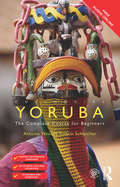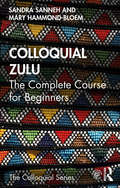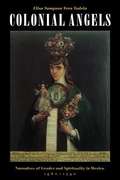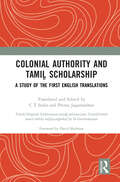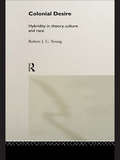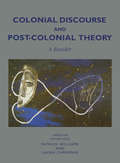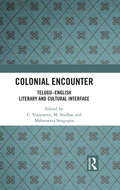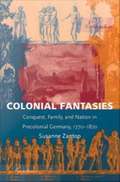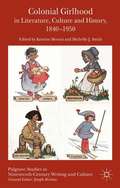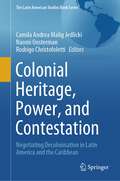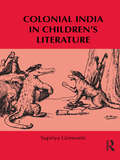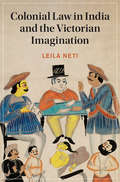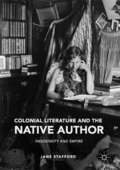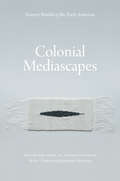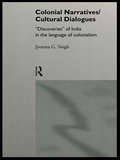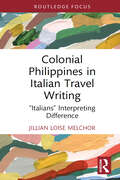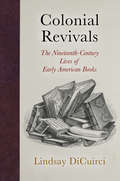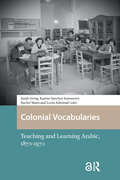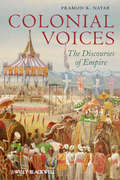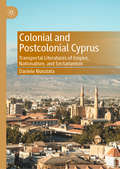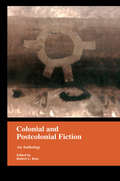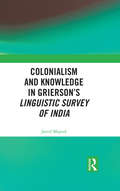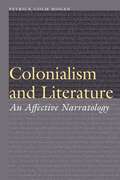- Table View
- List View
Colloquial Yoruba: The Complete Course for Beginners (Colloquial Ser.)
by Antonia Yetunde SchleicherColloquial Yoruba: The Complete Course for Beginners has been carefully developed by an experienced teacher to provide a step-by-step course to Yoruba as it is written and spoken today. Combining a clear, practical and accessible style with a methodical and thorough treatment of the language, it equips learners with the essential skills needed to communicate confidently and effectively in Yoruba in a broad range of situations. No prior knowledge of the language is required. Colloquial Yoruba is exceptional; each unit presents a wealth of grammatical points that are reinforced with a wide range of exercises for regular practice. A full answer key, a grammar summary, bilingual glossaries and English translations of dialogues can be found at the back as well as useful vocabulary lists throughout. Key features include: A clear, user-friendly format designed to help learners progressively build up their speaking, listening, reading and writing skills Jargon-free, succinct and clearly structured explanations of grammar An extensive range of focused and dynamic supportive exercises Realistic and entertaining dialogues covering a broad variety of narrative situations Helpful cultural points explaining the customs and features of life in Nigeria An overview of the sounds of Yoruba Balanced, comprehensive and rewarding, Colloquial Yoruba is an indispensable resource both for independent learners and students taking courses in Yoruba. Audio material to accompany the course is available to download free in MP3 format from www.routledge.com/cw/colloquials. Recorded by native speakers, the audio material features the dialogues and texts from the book and will help develop your listening and pronunciation skills.
Colloquial Zulu: The Complete Course for Beginners (Colloquial Series)
by Sandra Sanneh Mary Hammond-BloemColloquial Zulu is an easy-to-use and up-to-date guide to the Zulu language. Specially written for self-study or class use, the course offers you a step-by-step approach to written and spoken Zulu. No prior knowledge of the language is required. What makes Colloquial Zulu your best choice in language learning? It’s interactive – it has lots of exercises for regular practice. It’s clear – it has concise grammar notes. It’s practical – it has useful vocabulary and a pronunciation guide . It’s complete – it includes an answer key and reference section. Whether you’re a business traveller or you work for an NGO, whether you’re studying to teach or are looking forward to a holiday – if you’d like to get up and running with Zulu, this rewarding course will take you from complete beginner to confidently putting your language skills to use in a wide range of everyday situations. This course is also ideal for an institution-based setting with its clear language pedagogy, cultural information and notes. Accompanying audio material, recorded by native speakers, is available free online at www.routledge.com/cw/colloquials. The audio material will help develop your listening and pronunciation skills.
Colonial Angels: Narratives of Gender and Spirituality in Mexico, 1580-1750
by Sampson Vera Tudela ElisaThe author argues that the New World context necessitated the creation of a new kind of writing. Drawing on previously unpublished writings by and about nuns in the convents of Mexico City, she investigates such topics as the relationship between hagiography and travel narratives, male visions of the feminine that emerge from the reworking of a nun's letters to her confessor into a hagiography, the discourse surrounding a convent's trial for heresy by the Inquisition, and the reports of Spanish priests who ministered to noble Indian women. This research rounds out colonial Mexican history by revealing how tensions between Spain and its colonies played out in the local, daily lives of women.
Colonial Authority and Tamiḻ Scholarship: A Study of the First English Translations
by C T Indra and Prema JagannathanThis book—an English translation of a key Tamiḻ book of literary and cultural criticism—looks at the construction of Tamiḻ scholarship through the colonial approach to Tamiḻ literature as evidenced in the first translations into English. The Tamiḻ original Atikāramum tamiḻp pulamaiyum: Tamiḻiliruntu mutal āṅkila moḻipeyarppukaḷ by N Govindarajan is a critique of the early attempts at the translations of Tamiḻ literary texts by East India Company officials, specifically by N E Kindersley. Kindersley, who was working as the Collector of South Arcot district in the late eighteenth century, was the first colonial officer to translate the Tamiḻ classic Tirukkuṟaḷ and the story of King Naḷa into English and to bring to the reading public in English the vibrant oral narrative tradition in Tamiḻ. F W Ellis in the nineteenth century brought in another dimension through his translation of the same classic. The book, thus, focuses on the attempts to translate the Tamiḻ literary works by the Company’s officials who emerged as the pioneering English Dravidianists and the impact of translations on the Tamiḻ reading community. Theoretically grounded, the book makes use of contemporary perspectives to examine colonial interventions and the operation of power relations in the literary and socio-cultural spheres. It combines both critical readings of past translations and intensive research work on Tamiḻ scholarship to locate the practice of literary works in South Asia and its colonial history, which then enables a conversation between Indian literary cultures. In this book, the author has not only explored all key scholarly sources as well as the commentaries that were used by the colonial officials, chiefly Kindersley, but also gives us an insightful critique of the Tamiḻ works. The highlight of the discussion of Dravidian Orientalism in this book is the intralinguistic opposition of the “mainstream” Tamiḻ literature in “correct/poetical” Tamiḻ and the folk literature in “vacana” Tamiḻ. This framework allows the translators to critically engage with the work. Annotated and with an Introduction and a Glossary, this translated work is a valuable addition to our reading of colonial South India. The book will be of interest to researchers of Tamiḻ Studies, Orientalism and Indology, translation studies, oral literature, linguistics, South Asian Studies, Dravidian Studies and colonial history.
Colonial Desire: Hybridity in Theory, Culture and Race
by Robert J. YoungThe language of contemporary cultural theory shows remarkable similarities with the patterns of thought which characterised Victorian racial theory. Far from being marked by a separation from the racialised thinking of the past, Colonial Desire shows we are operating in complicity with historical ways of viewing 'the other', both sexually and racially.Colonial Desire is a controversial and bracing study of the history of Englishness and 'culture'. Robert Young argues that the theories advanced today about post-colonialism and ethnicity are disturbingly close to the colonial discourse of the nineteenth century. 'Englishness', Young argues, has been less fixed and stable than uncertain, fissured with difference and a desire for otherness.
Colonial Discourse and Post-Colonial Theory: A Reader
by Patrick Williams Laura ChrismanThis popular text provides an in-depth introduction to debates within post-colonial theory and criticism. The readings are drawn from a diverse selection of thinkers both historical and contemporary.
Colonial Encounter: Telugu–English Literary and Cultural Interface
by C. Vijayasree M. Sridhar Mahasweta SenguptaThis book focuses on transactions between English and Telugu through a study of translations and related works published from about the early-nineteenth century to mid-twentieth century. Moving beyond Edward Said’s theoretical paradigms which suggest that these interfaces were driven by imperial and colonial interests, the essays in this volume look at how they also triggered developments within the indigenous literary and cultural practices and evolved new forms of expression. The book will be of great interest to scholars and researchers of linguistics, translation studies, comparative literature, cultural studies and modern South Asian history.
Colonial Encounters in New World Writing, 1500-1786: Performing America
by Susan CastilloSusan Castillo’s pioneering study examines the extraordinary proliferation of polyphonic or ‘multi-voiced’ texts in the three centuries following the first contact between Europeans and the indigenous peoples of the Americas. Taking a selection of plays, printed dialogues, travel narratives and lexicographic studies in English, Spanish and French, the book explores both European and indigenous writers of the early Americas. Paying particular attention to performance and performativity in the texts of the early colonial world, Susan Castillo asks: why vast numbers of polyphonic and performative texts emerged in the Early Americas how these texts enabled explorers, settlers and indigenous groups to come to terms with radical differences in language, behaviour and cultural practices how dialogues, plays and paratheatrical texts were used to impose or resist ideologies and cultural norms how performance and polyphony allowed Europeans and Americans to debate exactly what it meant to be European or American, or in some cases, both. Tracing the dynamic enactment of (often conflictive) encounters between differing local narratives, Castillo presents polyphonic texts as not only singularly useful tools for exploring what initially seemed inexpressible or for conveying controversial ideas, but also as the site where cultural difference is negotiated. Offering unparalleled linguistic and historical range, through the analysis of texts from Spain, France, New Spain, Peru, Brazil, New England and New France, this volume is an important advance in the study of early American literature and the writings of colonial encounter.
Colonial Fantasies: Conquest, Family, and Nation in Precolonial Germany, 1770-1870
by Susanne ZantopSince Germany became a colonial power relatively late, postcolonial theorists and histories of colonialism have thus far paid little attention to it. Uncovering Germany's colonial legacy and imagination, Susanne Zantop reveals the significance of colonial fantasies--a kind of colonialism without colonies--in the formation of German national identity. Through readings of historical, anthropological, literary, and popular texts, Zantop explores imaginary colonial encounters of "Germans" with "natives" in late-eighteenth- and early-nineteenth-century literature, and shows how these colonial fantasies acted as a rehearsal for actual colonial ventures in Africa, South America, and the Pacific. From as early as the sixteenth century, Germans preoccupied themselves with an imaginary drive for colonial conquest and possession that eventually grew into a collective obsession. Zantop illustrates the gendered character of Germany's colonial imagination through critical readings of popular novels, plays, and travel literature that imagine sexual conquest and surrender in colonial territory--or love and blissful domestic relations between colonizer and colonized. She looks at scientific articles, philosophical essays, and political pamphlets that helped create a racist colonial discourse and demonstrates that from its earliest manifestations, the German colonial imagination contained ideas about a specifically German national identity, different from, if not superior to, most others.
Colonial Girlhood in Literature, Culture and History, 1840-1950
by Kristine Moruzi Michelle J. SmithColonial Girlhood in Literature, Culture and History, 1840-1950 explores a range of real and fictional colonial girlhood experiences from Jamaica, Mauritius, South Africa, India, New Zealand, Australia, England, Ireland, and Canada to reflect on the transitional state of girlhood between childhood and adulthood.
Colonial Heritage, Power, and Contestation: Negotiating Decolonisation in Latin America and the Caribbean (The Latin American Studies Book Series)
by Rodrigo Christofoletti Naomi Oosterman Camila Andrea Malig JedlickiRecent debates about the return of colonially looted heritage have furthered the discussions on decolonisation around the world, and have reignited questions surrounding “what is, and who owns, cultural heritage”. These discourses in the meaning, production and management of heritage – with a growing presence of themes that address “Latinities” – have gained greater visibility in Latin America and the Caribbean, as challenges surrounding cultural heritage arise more prominently worldwide. The attention on this region aims to contextualise the various theoretical, empirical, and critical perspectives in relation to the negotiation of decolonisation. Hence, this book focuses on the analysis of diverse modes of confronting the power underlying colonial heritage that can contribute to pushing boundaries and persuading changes in pre-established definitions of political thought and local identities. To this end, the chapters in this book focus on a wide scope of topics, ranging from the repatriation and restitution of cultural heritage, and diasporic movements to decolonial practices around monuments, museums, and education. In so doing, this volume challenges stereotypes that made Latin America and the Caribbean a space of mere reproducibility of external ideas, and instead provides a space to show current decolonial perspectives and practices developed in the region that will enrich the international debate on the contestation of colonial legacies and decolonisation of cultural heritage.
Colonial India in Children's Literature (Children's Literature and Culture #85)
by Supriya GoswamiColonial India in Children’s Literature is the first book-length study to explore the intersections of children’s literature and defining historical moments in colonial India. Engaging with important theoretical and critical literature that deals with colonialism, hegemony, and marginalization in children's literature, Goswami proposes that British, Anglo-Indian, and Bengali children’s literature respond to five key historical events: the missionary debates preceding the Charter Act of 1813, the defeat of Tipu Sultan, the Mutiny of 1857, the birth of Indian nationalism, and the Swadeshi movement resulting from the Partition of Bengal in 1905. Through a study of works by Mary Sherwood (1775-1851), Barbara Hofland (1770-1844), Sara Jeanette Duncan (1861-1922), Rudyard Kipling (1865-1936), Upendrakishore Ray (1863-1915), and Sukumar Ray (1887-1923), Goswami examines how children’s literature negotiates and represents these momentous historical forces that unsettled Britain’s imperial ambitions in India. Goswami argues that nineteenth-century British and Anglo-Indian children’s texts reflect two distinct moods in Britain’s colonial enterprise in India. Sherwood and Hofland (writing before 1857) use the tropes of conversion and captivity as a means of awakening children to the dangers of India, whereas Duncan and Kipling shift the emphasis to martial prowess, adaptability, and empirical knowledge as defining qualities in British and Anglo-Indian children. Furthermore, Goswami’s analysis of early nineteenth-century children’s texts written by women authors redresses the preoccupation with male authors and boys’ adventure stories that have largely informed discussions of juvenility in the context of colonial India. This groundbreaking book also seeks to open up the canon by examining early twentieth-century Bengali children’s texts that not only draw literary inspiration from nineteenth-century British children’s literature, but whose themes are equally shaped by empire.
Colonial Law in India and the Victorian Imagination (Cambridge Studies in Nineteenth-Century Literature and Culture #128)
by Leila NetiSituated at the intersection of law and literature, nineteenth-century studies and post-colonialism, Colonial Law in India and the Victorian Imagination draws on original archival research to shed new light on Victorian literature. Each chapter explores the relationship between the shared cultural logic of law and literature, and considers how this inflected colonial sociality. Leila Neti approaches the legal archive in a distinctly literary fashion, attending to nuances of voice, character, diction and narrative, while also tracing elements of fact and procedure, reading the case summaries as literary texts to reveal the common turns of imagination that motivated both fictional and legal narratives. What emerges is an innovative political analytic for understanding the entanglements between judicial and cultural norms in Britain and the colony, bridging the critical gap in how law and literature interact within the colonial arena.
Colonial Literature and the Native Author: Indigeneity and Empire
by Jane StaffordThis book is the first study of writers who are both Victorian and indigenous, who have been educated in and write in terms of Victorian literary conventions, but whose indigenous affiliation is part of their literary personae and subject matter. What happens when the colonised, indigenous, or 'native' subject learns to write in the literary language of empire? If the romanticised subject of colonial literature becomes the author, is a new kind of writing produced, or does the native author conform to the models of the coloniser? By investigating the ways that nineteenth-century concerns are adopted, accommodated, rewritten, challenged, re-inscribed, confronted, or assimilated in the work of these authors, this study presents a novel examination of the nature of colonial literary production and indigenous authorship, as well as suggesting to the discipline of colonial and postcolonial studies a perhaps unsettling perspective with which to look at the larger patterns of Victorian cultural and literary formation.
Colonial Mediascapes: Sensory Worlds of the Early Americas
by Matt Cohen Jeffrey GloverIn colonial North and South America, print was only one way of communicating. Information in various forms flowed across the boundaries between indigenous groups and early imperial settlements. Natives and newcomers made speeches, exchanged gifts, invented gestures, and inscribed their intentions on paper, bark, skins, and many other kinds of surfaces. No one method of conveying meaning was privileged, and written texts often relied on nonwritten modes of communication. Colonial Mediascapes examines how textual and nontextual literatures interacted in colonial North and South America. Extending the textual foundations of early American literary history, the editors bring a wide range of media to the attention of scholars and show how struggles over modes of communication intersected with conflicts over religion, politics, race, and gender. This collection of essays by major historians, anthropologists, and literary scholars demonstrates that the European settlement of the Americas and European interaction with Native peoples were shaped just as much by communication challenges as by traditional concerns such as religion, economics, and resources.
Colonial Narratives/Cultural Dialogues: 'Discoveries' of India in the Language of Colonialism
by Jyotsna SinghColonial Narratives/Cultural Dialogues demonstrates the continuing validity of the colonial paradigm as it maps the geographical, political, and imaginative space of 'India/Indies' from the seventeenth century to the present. Breaking new ground in postcolonial studies, Jyotsna Singh highlights the interconnections among early modern colonial encounters, later manifestations in the Raj and their lingering influence in the postcolonial Indian nationalist state. Singh challenges the assumption of eye-witness accounts and unmeditated experiences implcit in colonial representational practices, and often left unchallenged in the postcolonial era. Essential introductory reading for students and academics, Colonial Narratives/Cultural Dialogues re-evaluates the following texts: * seventeenth century travel narratives about India * eighteenth century 'nabob' texts * letters of the Orientalist, Sir William Jones * reviews of Shakespearean productions in Calcutta and postcolonial Indo-Anglian novels
Colonial Philippines in Italian Travel Writing: “Italians” Interpreting Difference (Routledge Focus on Literature)
by Jillian Loise MelchorThe first comprehensive review of all extant "Italian" chronicles set in the Philippine Islands, this book juxtaposes "Filipino" Otherness with the unique condition of "Italian" ambivalence and alterity within Europe.This book's contribution to the critical studies of travel is the opening of an analytical middle ground, highlighting the ambivalence of Italian chroniclers while acknowledging their participation in epistemological practices subsumed within the broader enterprise of conquest.Beyond the role of travel writing in colonial episteme, the book also situates the act of writing about one’s travels in instances of national character building (in Italy’s case) and in attempts of constructing a national historiography (in the Philippines' case). This manner of nuancing literary productions by the West while navigating its implications in the East, specifically, how pre-Unification “Italian” travel informed nationalist constructions in the Revolutionary Philippines, could enrich our understanding of and refract monolithic conceptions of metropole−periphery relations.
Colonial Revivals: The Nineteenth-Century Lives of Early American Books (Material Texts)
by Lindsay DiCuirciIn the long nineteenth century, the specter of lost manuscripts loomed in the imagination of antiquarians, historians, and writers. Whether by war, fire, neglect, or the ravages of time itself, the colonial history of the United States was perceived as a vanishing record, its archive a hoard of materially unsound, temporally fragmented, politically fraught, and endangered documents.Colonial Revivals traces the labors of a nineteenth-century cultural network of antiquarians, bibliophiles, amateur historians, and writers as they dug through the nation's attics and private libraries to assemble early American archives. The collection of colonial materials they thought themselves to be rescuing from oblivion were often reprinted to stave off future loss and shore up a sense of national permanence. Yet this archive proved as disorderly and incongruous as the collection of young states themselves. Instead of revealing a shared origin story, historical reprints testified to the inveterate regional, racial, doctrinal, and political fault lines in the American historical landscape.Even as old books embodied a receding past, historical reprints reflected the antebellum period's most pressing ideological crises, from religious schisms to sectionalism to territorial expansion. Organized around four colonial regional cultures that loomed large in nineteenth-century literary history—Puritan New England, Cavalier Virginia, Quaker Pennsylvania, and the Spanish Caribbean—Colonial Revivals examines the reprinted works that enshrined these historical narratives in American archives and minds for decades to come. Revived through reprinting, the obscure texts of colonial history became new again, deployed as harbingers, models, reminders, and warnings to a nineteenth-century readership increasingly fixated on the uncertain future of the nation and its material past.
Colonial Vocabularies: Teaching and Learning Arabic, 1870-1970 (Languages and Culture in History)
by Rachel Mairs Sarah Irving Karène Sanchez Summerer Lucia AdmiraalLanguage teaching and learning were crucial to Europeans’ colonial, national, and individual enterprises in the Levant, and in these processes, “Oriental language teachers” – as they were termed prior to the Second World War – were fundamental. European state nationalisms influenced and increasingly competed with each other by promoting their languages and cultures abroad, by means of both private and governmental actors. At the same time, learning Arabic became more prominent around the Mediterranean. The first half of the twentieth century corresponded with the emergence of new media; language was thought of as a cultural product to be exported into new cultural spaces. However, many blind spots remain in the history of linguistic thought and practices, including the forgotten and neglected voices of those involved in learning and teaching Arabic. This volume aims to revisit aspects of this linguistic encounter, including its vision, profile, priorities, trajectories, and practices. A discussion of Arabic teaching across a wide geographical and temporal range - Engaging case studies which add intriguing detail and colour to historical study - Siting of language study within highly topical colonial and postcolonial contexts and debates.
Colonial Voices: The Discourses of Empire
by Pramod K. NayarThis accessible cultural history explores 400 years of British imperial adventure in India, developing a coherent narrative through a wide range of colonial documents, from exhibition catalogues to memoirs and travelogues. It shows how these texts helped legitimize the moral ambiguities of colonial rule even as they helped the English fashion themselves.An engaging examination of European colonizers' representations of native populationsAnalyzes colonial discourse through an impressive range of primary sources, including memoirs, letters, exhibition catalogues, administrative reports, and traveloguesSurveys 400 years of India's history, from the 16th century to the end of the British Empire Demonstrates how colonial discourses naturalized the racial and cultural differences between the English and the Indians, and controlled anxieties over these differences
Colonial al-Andalus: Spain and the Making of Modern Moroccan Culture
by Eric CalderwoodThrough state-backed Catholicism, monolingualism, militarism, and dictatorship, Spain’s fascists earned their reputation for intolerance. It may therefore come as a surprise that 80,000 Moroccans fought at General Franco’s side in the 1930s. What brought these strange bedfellows together, Eric Calderwood argues, was a highly effective propaganda weapon: the legacy of medieval Muslim Iberia, known as al-Andalus. This legacy served to justify Spain’s colonization of Morocco and also to define the Moroccan national culture that supplanted colonial rule. Writers of many political stripes have celebrated convivencia, the fabled “coexistence” of Christians, Muslims, and Jews in medieval Iberia. According to this widely-held view, modern Spain and Morocco are joined through their shared Andalusi past. Colonial al-Andalus traces this supposedly timeless narrative to the mid-1800s, when Spanish politicians and intellectuals first used it to press for Morocco’s colonization. Franco later harnessed convivencia to the benefit of Spain’s colonial program in Morocco. This shift precipitated an eloquent historical irony. As Moroccans embraced the Spanish insistence on Morocco’s Andalusi heritage, a Spanish idea about Morocco gradually became a Moroccan idea about Morocco. Drawing on a rich archive of Spanish, Arabic, French, and Catalan sources—including literature, historiography, journalism, political speeches, schoolbooks, tourist brochures, and visual arts—Calderwood reconstructs the varied political career of convivencia and al-Andalus, showing how shared pasts become raw material for divergent contemporary ideologies, including Spanish fascism and Moroccan nationalism. Colonial al-Andalus exposes the limits of simplistic oppositions between European and Arab, Christian and Muslim, that shape current debates about European colonialism.
Colonial and Postcolonial Cyprus: Transportal Literatures of Empire, Nationalism, and Sectarianism
by Daniele NunziataThis book analyses colonial and postcolonial writing about Cyprus, before and after its independence from the British Empire in 1960. These works are understood as ‘transportal literatures’ in that they navigate the liminal and layered forms of colonialism which impede the freedom of the island, including the residues of British imperialism, the impact of Greek and Turkish nationalisms, and the ethnolinguistic border between north and south. This study puts pressure on the postcolonial discipline by evaluating the unique hegemonic relationship Cyprus has with three metropolitan centres, not one. The print languages associated with each centre (English, Greek, and Turkish) are complicit in neo-colonial activity. Contemporary Cypriot writers address this in order to resist sectarian division and grapple with their deferred postcoloniality.
Colonial and Postcolonial Fiction in English: An Anthology
by Robert RossFirst published in 1999. Routledge is an imprint of Taylor & Francis, an informa company.
Colonialism and Knowledge in Grierson’s Linguistic Survey of India
by Javed MajeedThis book is the first detailed examination of George Abraham Grierson’s Linguistic Survey of India, one of the most complete sources on South Asian languages. It shows that the Survey was characterised by a composite and collaborative mode of producing knowledge, which undermines any clear distinctions between European orientalists and colonised Indians in British India. Its authority lay more in its stress on the provisional nature of its findings, an emphasis on the approximate nature of its results, and a strong sense of its own shortcomings and inadequacies, rather than in any expression of mastery over India’s languages. The book argues that the Survey brings to light a different kind of colonial knowledge, whose relationship to power was much more ambiguous than has hitherto been assumed for colonial projects in modern India. It also highlights the contribution of Indians to the creation of colonial knowledge about South Asia as a linguistic region. Indians were important collaborators and participants in the Survey, and they helped to create the monumental knowledge of India as a linguistic region which is embodied in the Survey. This volume, like its companion volume Nation and Region in Grierson’s Linguistic Survey of India, will be a great resource for scholars and researchers of linguistics, language and literature, history, political studies, cultural studies and South Asian studies.
Colonialism and Literature: An Affective Narratology (Frontiers of Narrative)
by Patrick Colm HoganIn earlier work Patrick Colm Hogan argued that a few story genres—heroic, romantic, sacrificial, and others—recur prominently across separate literary traditions. These structures recur because they derive from important emotion-motivation systems governing human social interaction, such as group pride and shame. In Colonialism and Literature Hogan extends this work to argue that these genres play a prominent role in the fashioning of postcolonization literature—literature encompassing both the colonial and postcolonial periods. Crucially, colonizers and colonized people commonly understand and explain their situation in terms of these narrative structures. In other words, the stories we tell to some degree simply reflect the facts. But we also tend to interpret our condition in terms of genre, with the genre guiding us about what to record and how to evaluate it. Hogan explores these consequential processes in theoretical and literary analysis, presenting extended, culturally and historically specified interpretations of works by Pádraic Pearse (Ireland), Ngũgĩ wa Thiong&’o (Kenya), Yasujiro Ozu (Japan), J. M. Coetzee (South Africa), Margaret Atwood (Canada), Rabindranath Tagore (India), Abderrahmane Sissako (Mali), and Dinabandhu Mitra (India).
